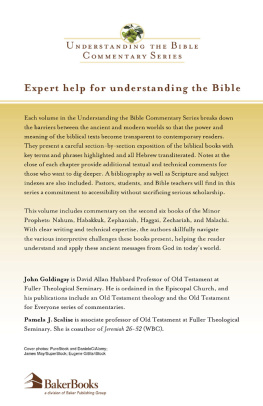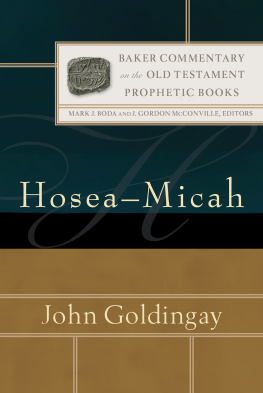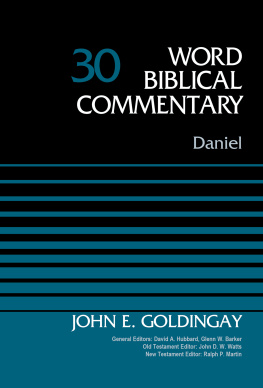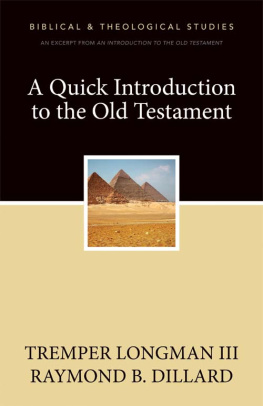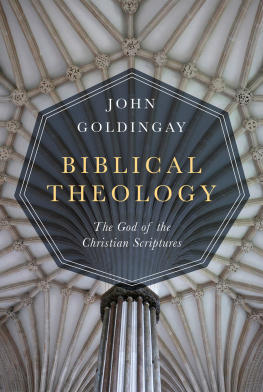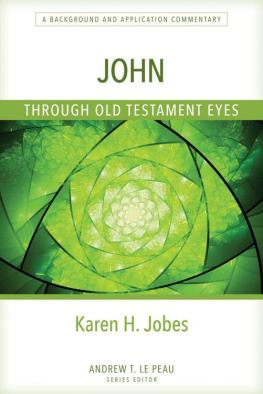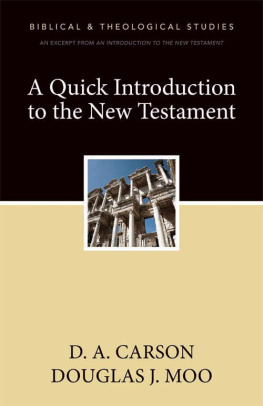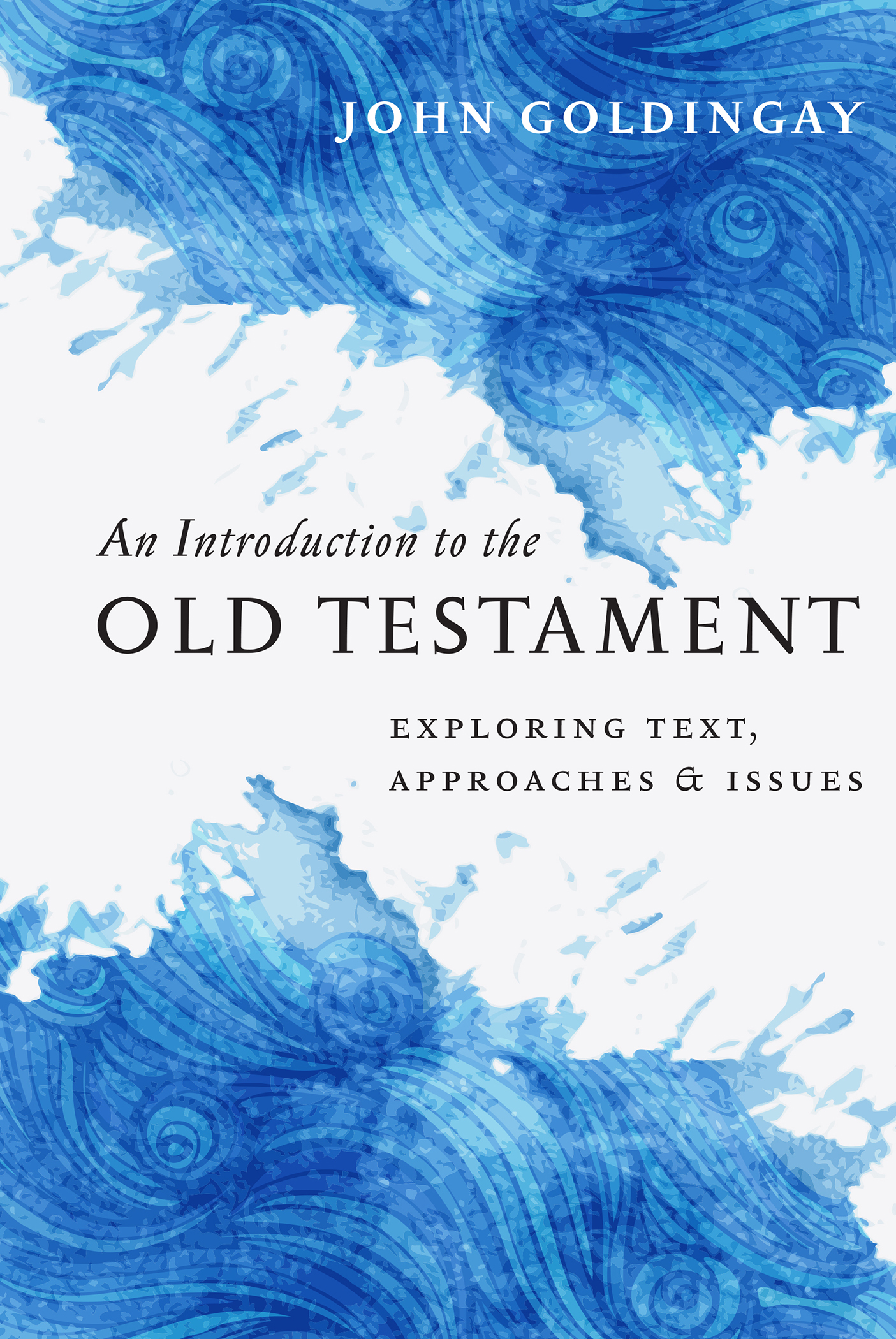An Introduction to the
OLD TESTAMENT
Exploring Text,
Approaches and Issues
JOHN GOLDINGAY
InterVarsity Press
P.O. Box 1400, Downers Grove, IL 60515-1426
ivpress.com
2015 by John Goldingay
All rights reserved. No part of this book may be reproduced in any form without written permission from InterVarsity Press.
InterVarsity Press is the book-publishing division of InterVarsity Christian Fellowship/USA, a movement of students and faculty active on campus at hundreds of universities, colleges and schools of nursing in the United States of America, and a member movement of the International Fellowship of Evangelical Students. For information about local and regional activities, visit intervarsity.org.
Cover design: Cindy Kiple
Images: Abstract background: viktor_vector/iStockphoto
ISBN 978-0-8308-9908-1 (digital)
ISBN 978-0-8308-4090-8 (print)
Library of Congress Cataloging-in-Publication Data
Goldingay, John.
An introduction to the Old Testament : exploring text, approaches & issues / John Goldingay.
1 online resource.
Includes index.
Description based on print version record and CIP data provided by publisher; resource not viewed.
ISBN 978-0-8308-9908-1 (eBook) ISBN 978-0-8308-4090-8 (casebound : alk. paper)
1. Bible. Old TestamentTextbooks. 2. Bible. Old TestamentIntroductions. I. Title.
BS1194
221.61dc23
2015027753
Contents
Preface
I n this introduction to Old Testament study my aim is to help you study Scripture for yourself. I spend little time telling you what the OT says or what scholars say. I focus more on giving you background material, noting approaches to interpretation, raising questions and suggesting approaches to questions. My goal is to provide you with a workbook, based on the material I use with my students and on my discovery of what works with them. After the introduction (part one) the main structure of the book follows the Jewish communitys division of the OT into the Torah (part two), the Prophets (part three) and the Writings (part four); then the conclusion to the book (part five) looks back over the whole. Full information on other books that I refer to also comes in the conclusion. The five parts are divided into self-contained two-page spreads, each of which has a number (101, 102, and so on). You can open the book at any point and be able more or less to understand that spread. You dont need to read the entire introduction before plunging into the study that starts in part two, or to read part two before part three. There is also considerable material on my webpage to supplement the material in this book (see Web Resources, which follows this preface).
I have implied already that its more important to help people read the Bible for themselves than to tell them what the Bible says. The Reformation displaced the pope as the person who decided what the Bible means, but its easy to replace the pope with pastors or professors, in which case youre no better off. My aim in this book is to help you study the Bible for yourself. I am told that there is a joke in Latin America: Catholics dont read the Bible because they think its too hard to understand; Protestants dont read it because theyre sure they already understand it. My experience is that Protestants in the United States are inclined to the alleged Catholic attitude. They assume that they need to be told what the Bible says by an expert. I believe that you can get to understand it. Further, there are limits to what anyone can teach you. Learning requires active involvement, thinking things out, ideally articulating things to other people and arguing things out, and applying things. Its a process that involves an interaction between experience and study and prayer.
I am grateful to Gillian Cooper, my Old Testament colleague at St. Johns Theological College, Nottingham, England, who got me to join in rethinking our aims and methods in teaching Old Testament in a way that bears this fruit twenty-five years later; to Robert Hubbard for accidentally sowing in my thinking the idea of writing this book and for commenting on much of the material; and to generations of students at St Johns Theological College and Fuller Theological Seminary, Pasadena, California, for questions that stimulated much of what I have thought and written, among them especially Kathleen Scott, who liked the course so much that she married me and has commented with insight on the material, though she wishes there were more of the jokes that come in my lectures but that Americans dont understand.
Biblical translations are my own from the Hebrew, Aramaic or Greek except where otherwise indicated.
Web Resources
T o supplement the material in this book, there is material at johngoldingay.com under the OT Introduction tab. This site includes more background material and more material suggesting implications for our own day. Youre welcome to print out and copy any of it. There are references to this web material throughout the book in the form of the phrases see or see further 119 or 245 or 363 or 442 or 507. These particular numbers refer to spreads at the end of each of the five parts of the book where you will find a list of the web material relating to each part of this book. The numbering of the web material resumes from the numbering at the end of each of the five parts of the book. The material also includes responses to many of the questions that students have asked when they have studied with me.
If you find you have questions that are not covered there, youre welcome to email me with them at . Ill answer as many as I can each week, and Ill add these questions and responses to the main body of questions and answers on the website. If that process stops, it means Ive died or gone gaga.
I expect I shall think of things to add to the web material as time goes by, and there is much more material under other tabs on that webpage. But this book itself is self-contained. While a few of the questions I suggest you think about involve looking at things on the web, otherwise you dont need access to the web in order to read the Bible, use this book and do the study I am suggesting.
Part One
Introduction
| 101 |
| 102 |
| 103 |
| 104 |
| 105 |
| 106 |
| 107 |
| 108 |
| 109 |
| 110 |
| 111 |
| 112 |
| 113 |
| 114 |
| 115 |
| 116 |
| 117 |
| 118 |
| 119 |
Approaching the Old Testament
T he Old Testament is the Christian term for the collection of scrolls in Hebrew and Aramaic that the Jewish community accepts as its Scriptures, and to which it often refers as the Torah [or Law], the Prophets and the Writings, or Tanak for short (from the initial letters of the three Hebrew nouns Torah, Nebiim, Ketubim). Scholars often refer to them as the Hebrew Bible. The books were written at different times between about the eighth century and the second century B.C. We dont know when they became a defined collection, when they became the Scriptures. From a Christian viewpoint, its significant that as far as we can tell, its the collection of Scriptures that Jesus and his first followers would have recognized; most of the books are quoted in the NT.


